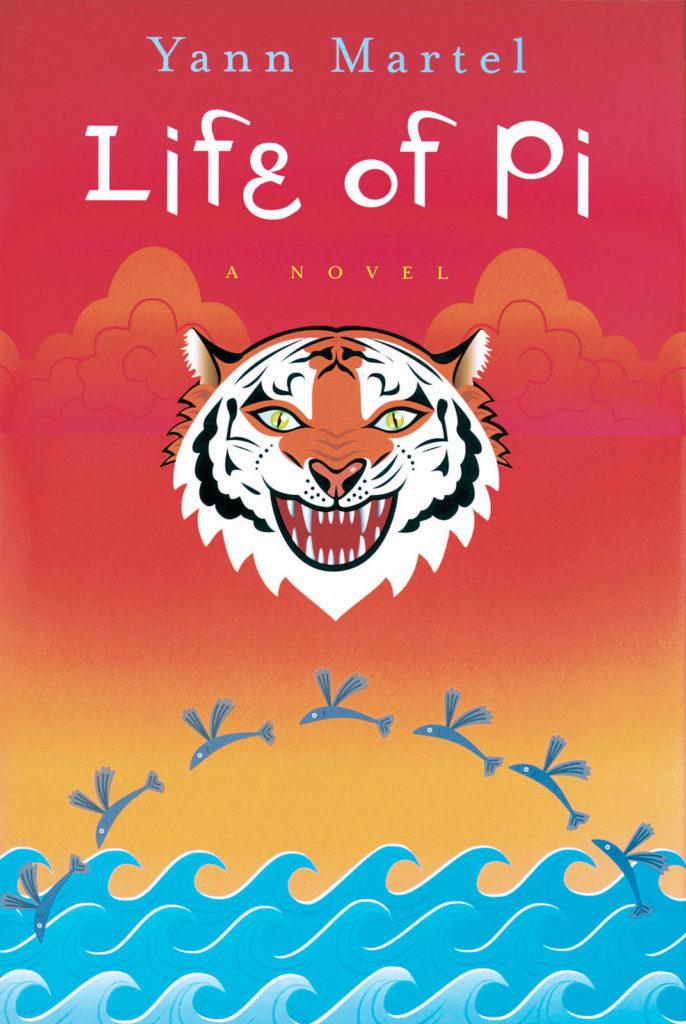Life of Pi by Yann Martel has been reviewed by Focus on the Family’s marriage and parenting magazine.

Life of Pi by Yann Martel has been reviewed by Focus on the Family’s marriage and parenting magazine.
Piscine Molitor Patel, Pi for short, grows up on the grounds of a small zoo in Pondicherry, India, where his father is the owner and zookeeper. A spiritually sensitive boy, Pi finds himself drawn to religion — all religions. He was born a Hindu and worships Hindu gods, but soon he also embraces Jesus, Mary and Mohammed. Every week, he worships at the Hindu temple, the Catholic church and the Islamic mosque. Although his parents tell Piscine that he can’t be more than one religion and his religious mentors from the three faiths have an ugly argument in front of him, Piscine persists. He believes that all religions are true and finds peace and satisfaction in the rituals of all three faiths.
When Pi is 16, his family plans to emigrate from India to Canada. Some of the zoo animals, to be sold in America, accompany them on a cargo ship. One night, Piscine wakes to what sounds like an explosion. He goes on deck to explore and soon finds himself alone in a lifeboat with an injured zebra, a hyena, an orangutan and a Bengal tiger named Richard Parker. The ship sinks with Pi’s whole family inside, and after the tiger finishes eating the other animals, Pi and the tiger are the only survivors.
For seven months, Pi and the tiger survive because Pi works to provide food and water for them both and trains the tiger to respect him and stay in his own part of the boat. Pi holds onto his belief that God, alternately called God, Krishna, Allah, Allah-Brahman and other names, is watching over him. The boy and tiger finally land in Mexico, and the tiger runs off into the forest. Officials from the shipping company have trouble believing Pi’s story, so he makes up a gruesome tale of murder and cannibalism instead. The officials leave believing that there is indeed a Bengal tiger loose in the forests of Mexico. Pi is placed with a Canadian foster mother and eventually graduates from the university, marries and has children of his own.
Although the author presents some Christian beliefs accurately, such as the fact that Jesus died to pay for mankind’s sin, the overall presentation is misleading, implying that both the Christian faith and the Bible have weaknesses and that Christianity is just one way to worship and work toward unity with the Brahman, the universal soul.
Pi believes that Lord Krishna led him to Jesus, Mary and Mohammed. The author presents Hinduism as an ideal belief system and Islam as the most peaceful and beautiful of religions. Pi’s pantheistic ideas cause him to compare himself to Cain and cry over killing his first fish. He talks of always remembering to pray for the souls of the dead animals. One time when he is trying to cheer himself up, he calls himself “God” and talks about everything around him belonging to this god (himself).
Both parents and religious leaders are presented as proper authority figures. However, Pi follows his own conscience in order to worship as he pleases.
There are several uses of p—, p—ing and one case of d–n and h—bent. Other uses of h— refer to the almost unbearable conditions of Pi’s life on the lifeboat. The book includes references to animal genitals and one to human genitals. Animals’ sexual habits and excretion are mentioned several times, sometimes humorously. Pi tastes and handles the tiger’s excrement and tastes human flesh. The descriptions of the deaths and dismemberments of animals and people by the tiger are detailed, but the worst graphic violence is Pi’s invented story of murder and cannibalism at the end of the book. It is excessively gory. In Chapter 87, Pi practices a form of mild asphyxiation as a method of escape.
There is one kiss between a husband and wife; one reference to a little girl’s kiss as a simile for the power and gentleness of scriptures (note: When Pi refers to scriptures, he means all scriptures, including the Koran, the Bible and the Hindu holy writings); and one reference to a man undressing to put on swim trunks.
Get free discussion questions for this book and others, at FocusOnTheFamily.com/discuss-books.
This book misrepresents Christianity and the Bible. It presents the idea that Hinduism, Islam and all religions are good.
Movie tie-in: Producers often use a book as a springboard for a movie idea or to earn a specific rating. Because of this, a movie may differ from the novel. To better understand how this book and the movie differ, compare the book review with Plugged In’s movie review for Life of Pi.
You can request a review of a title you can’t find at reviewrequests@family.org.
Book reviews cover the content, themes and worldviews of fiction books, not their literary merit, and equip parents to decide whether a book is appropriate for their children. The inclusion of a book’s review does not constitute an endorsement by Focus on the Family.